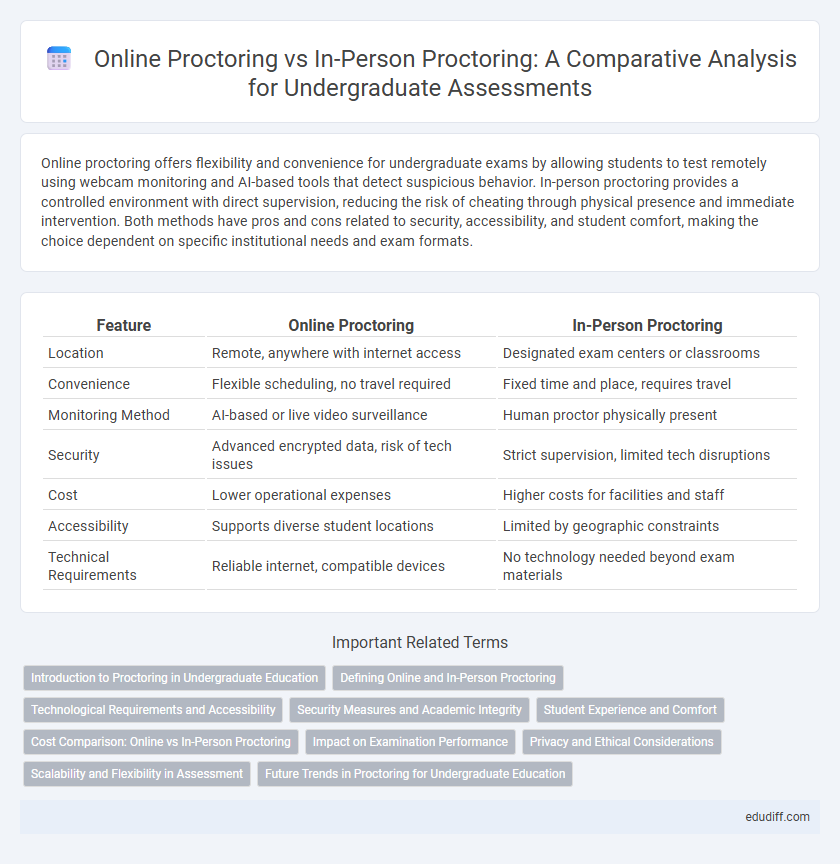Online proctoring offers flexibility and convenience for undergraduate exams by allowing students to test remotely using webcam monitoring and AI-based tools that detect suspicious behavior. In-person proctoring provides a controlled environment with direct supervision, reducing the risk of cheating through physical presence and immediate intervention. Both methods have pros and cons related to security, accessibility, and student comfort, making the choice dependent on specific institutional needs and exam formats.
Table of Comparison
| Feature | Online Proctoring | In-Person Proctoring |
|---|---|---|
| Location | Remote, anywhere with internet access | Designated exam centers or classrooms |
| Convenience | Flexible scheduling, no travel required | Fixed time and place, requires travel |
| Monitoring Method | AI-based or live video surveillance | Human proctor physically present |
| Security | Advanced encrypted data, risk of tech issues | Strict supervision, limited tech disruptions |
| Cost | Lower operational expenses | Higher costs for facilities and staff |
| Accessibility | Supports diverse student locations | Limited by geographic constraints |
| Technical Requirements | Reliable internet, compatible devices | No technology needed beyond exam materials |
Introduction to Proctoring in Undergraduate Education
Online proctoring in undergraduate education utilizes advanced AI and live monitoring to maintain academic integrity during remote assessments, providing flexibility and accessibility for diverse student populations. In-person proctoring relies on physical presence and direct supervision to ensure exam security, often limiting the examination environment to campus facilities. Both approaches aim to uphold assessment standards, with online proctoring increasingly integrating biometric verification and real-time behavioral analysis to detect potential violations.
Defining Online and In-Person Proctoring
Online proctoring involves monitoring exams remotely using webcams, screen-sharing, and AI technology to ensure exam integrity without physical presence. In-person proctoring requires a proctor to supervise students in a controlled, physical testing environment to prevent cheating. Both methods aim to uphold academic honesty but differ in their approach to supervision and security measures.
Technological Requirements and Accessibility
Online proctoring demands stable internet connectivity, compatible devices, and software with features like AI monitoring and identity verification, enabling flexible access for students in remote or diverse locations. In-person proctoring requires physical facilities, exam centers, and proctors, which may limit accessibility for students with mobility issues or those living far from testing sites. The technological infrastructure for online proctoring enhances scalability but depends heavily on digital literacy and reliable technology access.
Security Measures and Academic Integrity
Online proctoring employs advanced AI algorithms, biometric authentication, and continuous video monitoring to detect cheating behaviors and ensure exam security. In-person proctoring relies on physical presence, controlled exam environments, and direct supervision to maintain academic integrity and prevent unauthorized assistance. Both methods implement strict identity verification and real-time intervention protocols to uphold exam fairness for undergraduate assessments.
Student Experience and Comfort
Online proctoring offers undergraduate students the flexibility to take exams in familiar, comfortable environments, reducing travel-related stress and promoting better focus. In contrast, in-person proctoring provides a controlled setting that may increase anxiety due to strict supervision but ensures exam integrity through direct monitoring. Student experience often varies based on individual preferences for convenience versus the reassurance of traditional proctoring methods.
Cost Comparison: Online vs In-Person Proctoring
Online proctoring significantly reduces costs by eliminating the need for physical space, travel, and on-site staff, making it a budget-friendly option for undergraduate exams. In-person proctoring involves expenses such as facility rental, printed materials, and proctor wages, which can accumulate quickly for large-scale testing. Cost analysis shows that institutions save up to 60% by adopting online proctoring technologies over traditional in-person methods.
Impact on Examination Performance
Online proctoring offers flexibility and reduces test anxiety by allowing students to take exams in familiar environments, which can positively influence examination performance. In-person proctoring provides a controlled setting that minimizes academic dishonesty but may increase stress levels due to strict supervision. Research indicates that while online proctoring can enhance comfort and convenience, in-person exams often yield more reliable assessments of student knowledge.
Privacy and Ethical Considerations
Online proctoring raises significant privacy concerns due to continuous video monitoring, data storage risks, and potential unauthorized access to personal information. In-person proctoring offers a controlled environment with fewer digital privacy vulnerabilities but may still present ethical issues related to bias and unequal treatment. Choosing between these methods requires balancing privacy protection with fairness and transparency in academic integrity enforcement.
Scalability and Flexibility in Assessment
Online proctoring offers unparalleled scalability, enabling institutions to administer assessments to thousands of undergraduate students across multiple locations without the constraints of physical space. This flexibility supports diverse scheduling options, allowing learners to take exams at convenient times and accommodating varying time zones. In contrast, in-person proctoring requires fixed venues and scheduled sessions, limiting capacity and adaptability in large-scale undergraduate assessment environments.
Future Trends in Proctoring for Undergraduate Education
Future trends in proctoring for undergraduate education emphasize the integration of artificial intelligence and biometric authentication to enhance exam security and reduce cheating. Hybrid proctoring models combining online monitoring with in-person verification are gaining traction to balance flexibility and academic integrity. Advancements in machine learning algorithms enable real-time anomaly detection, ensuring more accurate and efficient remote exam supervision.
Online Proctoring vs In-Person Proctoring Infographic

 edudiff.com
edudiff.com